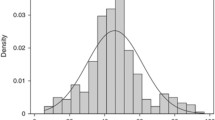Abstract
There is little professional consensusregarding the effect of economic conditionson House Elections. We argue that recentwork still uses the paradigm of Party toorganize their data and tests. Given thatrecent developments in the theory ofcongress emphasize the paradigm ofIncumbency, we investigate the empiricalrelevance of that competing paradigm. Weshow that (1) Incumbency matters in a purePresidential Party Model of HouseElections, (2) Presidential Party mattersin a pure Incumbency Model, (3) Once bothParty and Incumbency are accounted for,economic conditions exert a highlysignificant and temporally stable influenceon House elections, (4) Return Rates aremore affected by economic fluctuations thanare Vote Shares, and (5) Not allPresidential Party incumbents face the samedegree of electoral accountability foreconomic fluctuations.
Similar content being viewed by others
References
Alesina, A., Londregan, J. and Rosenthal, H. (1993). A model of the political economy of the United States. American Political Science Review 87: 12-33.
Ansolabehere, S., Brady, D. and Fiorina, M. (1992). The vanishing marginals and electoral responsiveness. British Journal of Political Science 22: 21-38.
Arcelus, F. and Meltzer, A., (1975). The effect of aggregate economic variables on Congressional elections, The American Political Science Review 69: 1232-1239
Biographical Directory, 1774-1989 (1989). Washington: Government Printing Office.
Campbell, J. (1986). Predicting seat gains from Presidential coattails, American Journal of Political Science 38: 165-183.
Cambell, J. (1997). The Presidential pulse and the 1994 midterm Congressional election. The Journal of Politics 59: 830.
Chappell, H. and Keech, W. (1985). A new view of political accountability for economic performance. American Political Science Review 79: 10-27.
Chappell, H. and Suzuki, M. (1993). Aggregate vote functions for the U.S. presidency, Senate, and House. Journal of Politics 55: 207-217.
Congressional Directory: 64th Congress. Washington, D.C.: Government Printing Office, Various Issues from May 1915 through 1996.
Congressional Quarterly Almanac. Washington, D.C.: Congressional Quarterly Inc., various issues.
Congressional Quarterly's Guide to Elections. (1985). 2nd ed. Washington, D.C.: Congressional Quarterly Inc.
Crain, W.M., Deaton, T. and Tollison, R. (1978). Macroeconomic determinants of tenure in the U.S. House of Representatives. Atlantic Economic Journal 6: 79-83.
Davidson, R. and Olesek, W. (1990). Congress and its members. Washington D.C.: Congressional Quarterly Press.
Dickey, D. and Fuller, W. (1979). Distribution of the estimators for autogressive time series with a unit root. Journal of the American Statistical Association 74: 427-431.
Erikson, R. (1988). The puzzle of midterm loss. Journal of Politics 50: 1011-1029.
Erikson, R. (1990). Economic conditions and the Congressional vote: A review of the macrolevel evidence. American Journal of Political Science 34: 373-399.
Ferejohn, J. (1986). Incumbent performance and electoral control. Public Choice 50: 5-26.
Fiorina, M. (1989). Congress, keystone of the Washington establishment. Yale University Press.
Goodman, S. and Kramer, G.H. (1975). The effect of aggregate economic conditions on Congressional elections: Comment. American Political Science Review 69: 1255-1265.
Groseclose, Timothy, and Keith Krehbiel. Rubber Checks and Golden Parachutes American Journal of Political Science, 1994.
Grier, K. and McGarrity, J.P. (1998). The effect of macroeconomic fluctuations on the electoral fortunes of House incumbents. Journal of Law and Economics 41: 143-161.
Hibbing, J. and Alford, J. (1981). The electoral impact of economic conditions: Who is held responsible?. American Journal of Political Science 25: 423-439.
Historical statistics of the United States, colonial times to 1970. (1975). Washington: Bureau of the Census.
Jacobson, G. (1987). The marginals never vanished: Incumbency and competition in elections to the U.S. House of Representatives: 1952-1982. American Journal of Political Science 31: 126-141.
Jacobson, G. (1990). Does the economy matter in mid-term elections? American Journal of Political Science 34: 400-404.
Kramer, G.H. (1971). Short-term fluctuations in U.S. voting behavior. American Political Science Review 65: 131-143.
Lewis-Beck, M.S. and Rice, T. (1984). Forecasting U.S. House elections. Legislative Studies Quarterly 9: 475-486.
Long Term Economic Growth: 1970. (1970). Washington: Bureau of Economic Analysis.
Mayhew, D. (1974). Congress: The electoral connection. Yale University Press.
Oppenheimer, B., Stimson, J. and Waterman, R. (1986). Interpreting U.S. House elections: The exposure thesis. Legislative Studies Quarterly, 11: 227-247.
Peltzman, S. (1990). How efficient is the voting market?. Journal of Law and Economics 33.
Polsby, N. (1968). The institutionalization of the U.S. House of Representatives. American Political Science Review 62: 144-168.
Rogoff, K. (1990). Equilibrium political budget cycles. American Economic Review 80.
Stigler, G. (1973). Micropolitics and macroeconomics. American Economic Review 67: 160-167.
Statistical Abstract of the U.S.. Bureau of Statistics, Treasury Department, various issues.
Survey of Current Business (1991). Department of Commerce, Bureau of Economic Analysis, Vol. 27.
Tufte, E. (1975). Determinants of the outcomes of midterm congressional elections. American Political Science Review 69: 812-826.
Tufte, E. (1973). The relationship between seats and votes in two-party systems. The American Political Science Review 67: 540-553.
U.S. Department of Labor. (1992). Consumer price index, computer printout, Oct. 15.
Author information
Authors and Affiliations
Rights and permissions
About this article
Cite this article
Grier, K.B., McGarrity, J.P. Presidential Party, Incumbency, and the Effects of Economic Fluctuations on House Elections, 1916–1996. Public Choice 110, 143–162 (2002). https://doi.org/10.1023/A:1013073122941
Issue Date:
DOI: https://doi.org/10.1023/A:1013073122941




